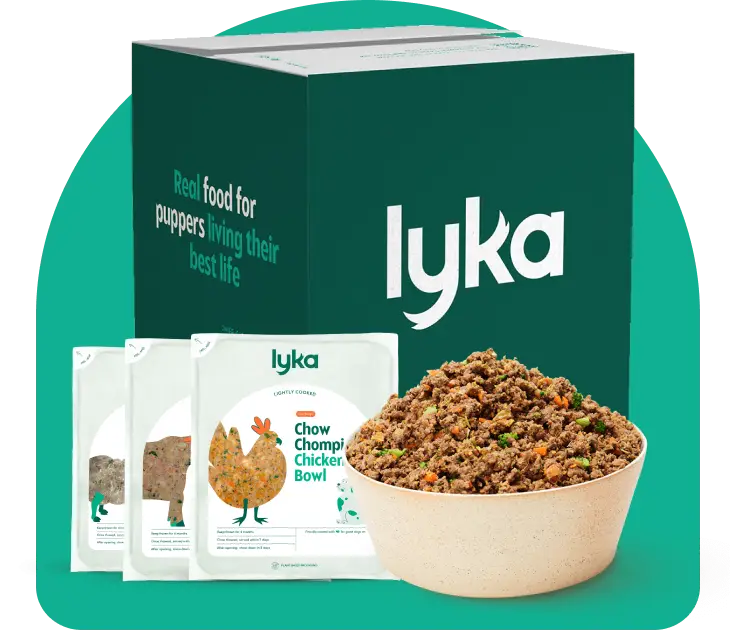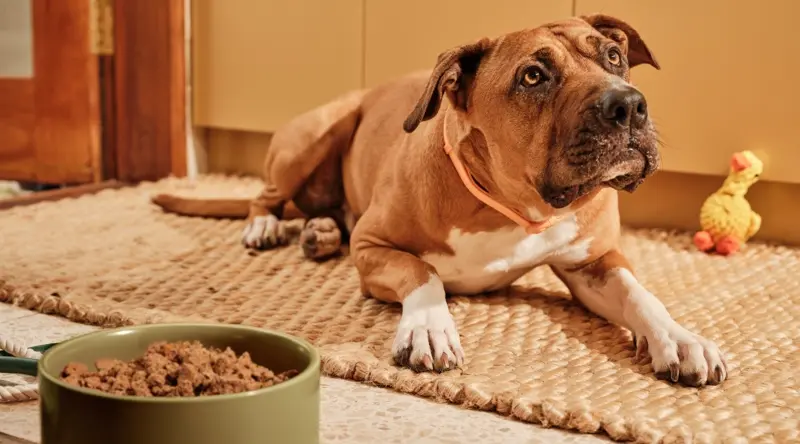Seeing your dog in pain or discomfort is hard — especially when you've tried everything and still can’t pinpoint the cause. Gut issues are common in dogs, but this doesn’t always mean there’s a quick fix. Investigating their diet, however, is a good first step.
In 50% - 66% of all chronic gut health cases, dogs see an improvement in symptoms after making a diet change. Dr Matthew Muir, Lyka Co-founder and Integrative Veterinarian, shares this passion about the role of nutrition: real food can boost the health of the microbiome, putting your pup on a path towards long-term relief.
Let's break down the vet-speak — what exactly is CCE?
CCE stands for Canine Chronic Enteropathy: it’s a broad diagnosis for dogs with long-term symptoms of gut issues, with no other known cause.
)
CCE includes four subtypes:
Food Responsive Enteropathy (FRE)
Antimicrobial Responsive Enteropathy (ARE)
Immunomodulation Responsive Enteropathy (IRE)
Non Responsive Enteropathy (NRE)
This new terminology means parents can detect issues sooner with vet support — with more potential for early intervention, and higher chances of successful treatment as a result.
What are the signs of chronic digestive issues in dogs?
Symptoms of chronic digestive issues can come and go. You might notice there are periods of time where your pup is struggling with their discomfort and pain much more, followed by blocks of time with less severe symptoms — they may even disappear before returning. Symptoms are the same across all types of Chronic Enteropathy — the difference lies in how your dog responds to treatment.
)
Common symptoms:
Vomiting — as a one off, or intermittently
Diarrhoea or more than three poos per day
Weight loss
Fussiness or changes in appetite
Regular foul-smelling wind
Changes in mood and behaviour
Less common symptoms:
Constipation
Reflux
Bright red blood in stools (hematochezia)
Black tarry stools (melena)
Vomiting blood, either bright red or dark and brown like coffee grounds (hematemesis)
Frequent need to go to the bathroom (tenesmus)
If your dog’s poo or vomit fits this description, speak to your vet immediately.
)
)
How can I manage chronic gut issues in my dog?
Managing CE is like figuring out the combination to a lock: it can depend on multiple factors, and requires a holistic approach to health. There are some factors (like breed) that you can’t control, while you may be able to modify other factors (like reducing irritants in their environment).
“It depends” might not seem like a very helpful answer — especially if you’re trying to help your dog right now — but nutrition is a great place for many parents to start.
The four types of Chronic Canine Enteropathy
1. Responsive to changes in diet
Food Responsive Enteropathy (FRE) is the most common subtype. It’s more common in younger dogs and can happen because of allergies or intolerances to a specific ingredient — but this isn’t always the cause. FRE can result from the way a dog’s food is formulated. Some pups, for instance, will need more or less fat, protein, carbohydrates, or fibre.
If your veterinarian has advised you remove the ingredient in question from their diet, improvement usually occurs within 14 days of the change.
Some dogs will need to complete an elimination diet, and it may take some trial and error to find what works best. This could mean feeding a bland diet for 12 weeks and slowly reintroducing individual ingredients to identify triggers, or reverting to their old food if you observe re-emerging symptoms.
Don’t rule out Food Responsive Enteropathy (FRE) after only one diet trial, and speak to your vet about trialling a varied and digestible option. This study found that dogs’ symptoms improved after switching from a high carbohydrate, low protein food to a high protein, low carbohydrate alternative (like Lyka). If your pup responds well to this, it could prevent the need for unnecessary medication.
2. Responsive to changes in the microbiome
This subtype — known as Antimicrobial Responsive Enteropathy (ARE) — is a treatment that aims to targets problematic strains of gut bacteria, like antibiotics. Unlike antibiotics, this approach doesn’t destroy all bacteria: both bad and good.
In the past, antibiotics have been used to address chronic gut health problems — but symptoms often return, along with increased antibiotic resistance and unhealthy changes in the composition of the microbiome.
Gastrointestinal upsets have a clear link with the health and balance of your dog’s microbiome. An imbalance in gut bacteria (known as dysbiosis) can negatively effect CCE symptoms, if there is:
An overgrowth of harmful bacteria
Lack of diversity in the types of bacteria
Absence of “good” bacteria that promotes health
There are other ways to shape the balance of gut bacteria without using antibiotics, according to a growing number of integrative vets and internal medicine specialists. This could include introducing herbs, nutraceuticals, probiotics, or MBRT.
3. Responsive to medication suppressing the immune system
This subtype — formerly known as inflammatory bowel disease (IBD) — has a few different names, with the most common being Immunomodulation Responsive Enteropathy. Only 1-2% of dogs are diagnosed with IBD, compared to 17.8% that have CCE, and it’s more common in older dogs.
The medications prescribed suppress your dog’s immune response, which can reduce inflammation in the lining of the gastrointestinal tract. While useful, these medications are best avoided unless absolutely necessary — they can have significant side effects including behavioural shifts and negative gastrointestinal ulceration.
If your dog is prescribed this medication, speak to your veterinarian about other potential approaches to management in the future. It may be possible to reduce the dose if your pup responds well to other changes to their diet or microbiome.
4. Non Responsive Enteropathy (NRE)
Unfortunately, 15% - 40% of all Canine Chronic Enteropathy cases don’t respond to treatment in the short term: which could point to the presence of an underlying health condition.
If you feel like you’ve tried everything to no avail, don’t lose hope — you may want to consider trialling another diet like Lyka, with the guidance of a holistic vet. They can also suggest other approaches like introducing herbs, or treatments like acupuncture.
FAQs for parents of pups with digestive issues
What’s the best dog food for older dogs with digestive issues?
As your dog ages, their gut bacteria changes: influencing the health of their digestive and nervous systems. We’ve put together a guide on what to feed senior dogs, which includes recommendations for parents of pups with digestive issues.
The main thing to remember is the role of prebiotic foods — supercharged by antioxidant properties. Turmeric and blueberries, for example, have restorative effects for your dog's gut: strengthening their gut lining while creating a health balance of bacteria.
What’s the best probiotic for dogs with digestive issues?
The best probiotic is a prebiotic. Some types of real food — a rainbow of fruits, vegetables, and superfoods — can have prebiotic effects for dogs. You can also promote your pup’s gut health with Lyka's Go-to-Gut Helper, a probiotic supplement formulated to promote a diverse and balanced microbiome.
Could my dog have a nutritional deficiency?
As many as 30% of dogs with CCE have a Vitamin B12 deficiency. If your dog is experiencing issues with their digestive health, your veterinarian can test for this, and make suggestions to combat it. Vitamin B12 is essential for healthy digestion, which is why our range contains an average Vitamin B12 amount 3.29x higher than AAFCO minimum requirements. Lyka’s Turkey Bowl is made with sensitive tummies in mind, being packed with fermentable fibre and bioactive ingredients to ease inflammation.
Lyka makes sensitive tummies a thing of the past
Changes to your dog’s nutrition is the most common solution for gut issues — and it’s most often associated with long-term remission (longer than 3 months). It takes the right formulation of quality ingredients to keep the microbiome healthy — Lyka makes this easy.
Our food is formulated by a team of board-certified veterinary nutritionists based on your dog’s nutritional needs. Lyka is packed with nutrients, leading to healthier poos, gut lining repair, and a steadier flow of energy throughout the day.
)
Consider speaking to your veterinarian about Lyka as an option — especially if your pup hasn’t tried it as part of a diet trial. Our friendly Customer Care team is always available for a chat and can provide more information about how our food eases and improves chronic gut issues.
)
)
)
)

)
)
)
)
)
